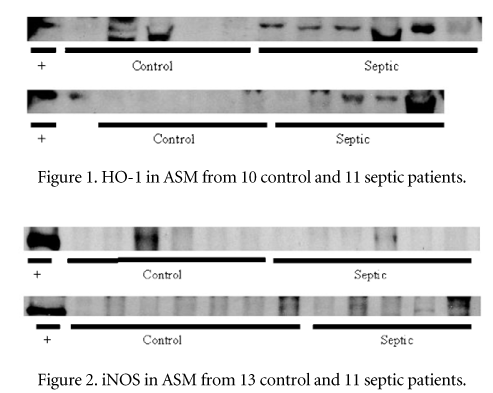Carbon monoxide, produced by heme oxygenase (HO-1), and nitric oxide, produced by inducible nitric oxide synthase (iNOS), both cause vasodilatation by activating guanylate cyclase. Overproduction of nitric oxide by iNOS is commonly thought to be the principal cause of hypotension in sepsis. However, iNOS knockout mice, whose nitric oxide production was not increased when exposed to lipopolysaccharide, were no more resistant to sepsis than normal mice (Laubach et al. 1995).
We recently demonstrated increased HO-1 (Reade et al. 2002a) and decreased iNOS (Reade et al. 2002b) mRNA in mesenteric arterial smooth muscle (ASM) from patients with septic shock. We have now determined the protein expression of HO-1 and iNOS in these patients.
ASM was isolated from patients undergoing bowel resection for perforated viscus (who in the peri-operative period met the accepted criteria for septic shock), and from controls with bowel cancer. After mechanical removal of endothelium and adventitia, tissue was homogenised in protease inhibitor and frozen until sufficient samples had been accumulated. Western blotting was performed under reducing conditions, with membranes incubated in 1:2000 (iNOS) or 1:1000 (HO-1) primary antibody followed by 1:2000 peroxidase-labelled secondary antibody. Protein bands were quantified by computer analysis of the chemiluminescence detection film, then normalised to the protein concentration of the sample prior to dilution.
HO-1 protein expression was significantly increased in arterial smooth muscle from patients with septic shock (2.2 ± 1.7 units mg-1 control; 46 ± 15 units mg-1 septic) (means ± S.E.M.; n = 10 controls, 11 septics; P = 0.015, Student’s unpaired t test) (Fig. 1). There was no increase in expression of iNOS; indeed iNOS protein was only detectable in ASM from two controls and three septics (Fig. 2).
We suggest that overexpression of heme oxygenase, rather than iNOS, might be responsible for the hypotension that characterises human septic shock.
This study was approved by the Central Oxfordshire Research Ethics Committee.
M.C.R. is supported by a Brasenose College Graduate Studentship and a Royal North Shore Hospital of Sydney Medical Fellowship.
All procedures accord with current local guidelines.

